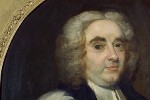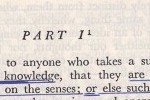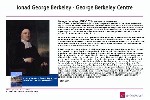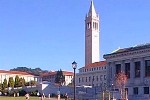George Berkeley Centre
George Berkeley (1685-1753), philosopher and Anglican bishop.
Born in Kilkenny; he attended Kilkenny College and TCD, graduating in 1701. He was ordained in the Anglican Church in the Continent, and in America, where he lived in Rhode Island. He had gone to America with the aim of establishing a college in Bermuda but never received the money he had been promised. However, he had considerable influence on education in America. His later years, from 1734 on, were mostly spent in Ireland, where he was Bishop of Cloyne, carrying out his Episcopal duties with generous concern for the well–being of all who lived in his diocese. He died in Oxford, where his son was a student, in 1753.
His works include essays on motion, vision, topics in mathematics and theology, as well as his contributions in philosophy. His first important philosophical work was An Essay towards a New Theory of Vision (1709). This was followed by A Treatise concerning the Principles of Human Knowledge (1710) and Three Dialogues between Hylas and Philonous (1713). Later important works include Alciphron (1732), a largely theological treatise, THE QUERIST (1735-52) and Siris (1744) in which the medicinal properties of tar water are extolled.
Berkeley is an extremely important figure in the history of philosophy and more broadly in the history of ideas. His work is well known far beyond the English-speaking world; in the United States, the city of Berkeley, California and its university are named after him. Though his philosophical views are subtle and ingenious, the main themes are accessible. In the entire universe there are only minds and ideas. The existence of minds consists in perceiving, whereas the existence of ideas, including sensations, consists in being perceived. Physical objects consist of qualities – the very qualities we observe them to have; and qualities are sensations. Hence, the existence of physical objects consists in being perceived. Thus Berkeley endorses the idealist view that the physical world depends upon the mind; consequently there is no need for material substance. (Indeed he argued at length that the very concept of material substance is incoherent). The sensations that constitute the physical world are given to us by God, the one infinite mind. Since God is their source, we are constantly in intimate contact with God, and we can therefore always reasonable be certain of God existence. Berkeley is not saying that the world is an illusion; it does not have mind-independent existence, but is nevertheless real and we perceive it directly, and accurately. There is no room for the sort of scepticism that is possible if, with many of Berkeley’s predecessors, we were to accept that we can never get beyond a veil of ideas through which we perceive a mind-independent material world. Scepticism of this sort cannot get a foothold in Berkeley’s system, because the perceived is the real or as he put it, “to be is to be perceived”.
George Berkeley (1685-1753), Fealsamh
Rugadh i gCill Chainnigh é; d’fhreastal sé ar Choláiste Chill Chainnigh agus ar Choláiste na Tríonóide, ag baint céime amach i 1701. Rinneadh ministir oirnithe de san eaglais Anglacánach i 1709 agus chaith sé an chuid is mó den tréimhse 1712-34 thar lear i Londain, ar an Mór-Rionn agus i Meiriceá, áit a raibh cónaí air ar Rhode Island…Bhí an t-ionchar aige ar an oideachas i Meiriceá. Ó 1734 ar aghaidh, chaith sé an chuid is mó dá shaol in Éirinn agus é ina Easpag ar Dheoise Chluana i mbun a chuid duaglas Easpagach le curam flaithiúil aige do gach uile duine a bhí ina chónaí ina dheoise. D’éag sé in Oxford, áit a raibh a mhac ina scoláire ann i 1753.
Scriobh sé roinnt aistí ar ghluaiseacht, ar radharc, ar ábhair éagsúla sa mhatamatic, agus i ndiagacht, chomh maith leis an bhfealsúnacht. Ba é An Essay towards a New Vision (1709) an chéad mór-obair fhealsúnachta. Lean sé é sin le A Treatise concerning the Principles of Human Knowledge (1710) agus Three Diaologues between Hylas and Philonous (1713), níos déanaí, chruthaigh sé saothair thábhachtacha eile cosúil le Alciphron (1732), tráchtas diagachta ab ea é sin don chuid is mó, The Querist (1735-52) agus Siris (1744) ina moltar tréithe miochaineacha uisce tarra.
Is figiúr an-tábhachtach é Berkeley i stair na fealsúnachta agus nios leithne, i stair na smaointeoireachta… Sna Stáit Aontaithe, tá cathair Berkeley i gCalifornia agus an ollscoil úd ainmnithe ina onóir. Fiú agus a dhearcadh fealsúnachta chomh caolchúiseach agus éirimiúil sin, tá na príomhtéamaí iontu insroichte go leor. San uilebhith, níl ann ach meabhair agus smaointe. Tá beithsine na meabhrach bainteach le haireachtáil, ach tá beithsine na smaointe, mothúcháin san áireamh, bainteach le bheith airithe. Tá cáiliochtaí faoi leith ag rudaí fisiciúla – na cáiliochtaí a fheictear leo; agus is mothúcháin iad na cáilíochtaí sín. Dá bhrí sin, is éard atá i mbeihsine na nithe fisiciúla ná na nithe sin a bheith airithe. Is aimhlaidh go bhformhuiníonn Berkeley an dearcadh idéalaíoch sin go bhfuil an domhan fisiciúil ag brath ar an meabhair; mar thoradh air seo, níl gá ar bith le substaint ábharach. (Go deimhin, d’áitigh sé go tréan go raibh coincheap fhéin na substainte ábharaigh neamhleanúnach). Thug Dia na mothúcháin atá i gcomhdhéanamh an domhain fhisiciúil dúinn, an t-aon mheabhair infinideach. Toisc go bhfuil Dia mar fhoinse dóibh, táimid i dteagmháil go dlúth le Dia i gcónaí agus is féidir linn a rá go réasúnta mar sin le cinnteacht go bhfuil Dia ann. Níl Berkeley árá gur meabhal is ea na domhan; níl beithsine meabhrach neamhspleách aige, ach tá sé réalta agus airimid go direach é, agus go cruinn. Níl spás ar bith don chineál sceipteachais atá féidearthach má ghlacaimid leis, cosúil le go leor do réamhtheachtaithe Berkeley, nach mbeimid in ann dul thar na smaointe trína n-airimid an domhan ábharach atá meabhar-neamhspléach. Ní féidir le sceipteachas den chineál seo seasamh a aimsiú i gcóras Berkeley toisc gur ionann an méid a airíodh agus an méid atá réalta, nó mar a dúirt sé féin, ‘to be is to be perceived’.



